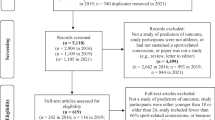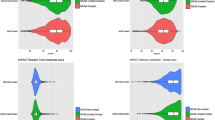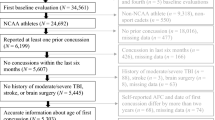Abstract
Background
Concussion diagnosis and management is made through the clinical exam using assessment tools that include self-report symptomatology, postural control, and cognitive evaluations. The specific timing of concussion resolution varies between individuals. However, despite a lack of research in concussion recovery, it is widely accepted that the majority of young adults will recover in 7–10 days, with youth athletes taking longer.
Objectives
The purpose of this review is to directly compare the recovery duration among high school and collegiate athletes on symptom reports and cognitive assessments following concussion.
Data Sources
Data were collected from a literature search comprising high school or college athletes only. This included studies (n = 6) that reported symptom or cognitive performance recovery to the exact day.
Results
High school athletes self-reported symptom recovery at 15 days compared with 6 days in collegiate athletes. Both college and high school athletes showed cognitive recovery at similar rates of 5 and 7 days.
Limitations
This review only included articles that were directly related to concussed high school or college athletes. Additionally, athletes in the high school and college setting typically receive a battery of neurocognitive tests that may not be as sensitive or as comprehensive as a full neuropsychological exam.
Conclusion
The review finds that neurocognitive recovery rates are similar among high school and college athletes, while symptom reporting shows longer recovery time points in high school than in college.
Implications of Key Findings
An individualized and stepwise concussion management plan is important for proper concussion recovery regardless of age.





Similar content being viewed by others
References
McCrory P, Meeuwisse WH, Aubry M, Cantu B, Dvorak J, Echemendia RJ, et al. Consensus statement on concussion in sport—the 4th international conference on concussion in sport held in Zurich, November 2012. Br J Sports Med. 2013;47(5):250–8.
Langlois JA, Rutland-Brown W, Wald MM. The epidemiology and impact of traumatic brain injury: a brief overview. J Head Trauma Rehab. 2006;21(5):375–8.
Buzzini SR, Guskiewicz KM. Sports-related concussion in the young athlete. Curr Opin Pediatr. 2006;18:376–82.
Guskiewicz K, Weaver N, Padua D, Garrett W. Epidemiology of concussion in collegiate and high school football players. Am J Sport Med. 2000;28:643–50.
Guskiewicz K, McCrea M, Marshall S, Cantu R, Randolph C, Barr W. Cumulative effects associated with recurrent concussion in collegiate football players: The NCAA concussion study. J Am Med Assoc. 2003;290(19):2549–55.
Powell JW, Barber-Foss KD. Traumatic brain injury in high school athletes. J Am Med Assoc. 1999;282(10):958–63.
Lovell MR, Collins MW, Iverson GL, Field M, Maroon JC, Cantu R, et al. Recovery from mild concussion in high school athletes. J Neurosurg. 2003;98(2):296–301.
Pellman EJ, Lovell MR, Viano DC, Casson IR, Tucker AM. Concussion in professional football: neuropsychological testing–part 6. Neurosurg. 2004;55(6):1290–303 (discussion 303–5).
Hootman JM, Dick R, Agel J. Epidemiology of collegiate injuries for 15 sports: summary and recommendations for injury prevention initiatives. J Athl Train. 2007;42(2):311–9.
Gessel LM, Fields SK, Collins CL, Comstock R. Concussions among United States high school and collegiate athletes. J Athl Train. 2007;42:495–503.
Broglio SP, Cantu RC, Gioia GA, Guskiewicz KM, Kutcher J, Palm M, Valovich McLeod TC. National Athletic Trainers’ Association position statement: management of sport concussion. J Athl Train. 2014;49(2):245–65.
Herring SA, Cantu RC, Guskiewicz KM, Putukian M, Kibler WB, Bergfeld JA, et al. Concussion (mild traumatic brain injury) and the team physician: a consensus statement—2011 update. Med Sci Sports Exerc. 2011;43(12):2412–22.
Meehan WP 3rd, Micheli LJ. Concussion results in deficits in neurocognitive functioning. Preface. Clin Sports Med. 2011;30(1):xvii–iii.
Macciocchi SN, Barth JT, Alves W, Rimel RW, Jane JA. Neuropsychological functioning and recovery after mild head injury in collegiate athletes. Neurosurgery. 1996;39(3):510–4.
Ellemberg D, Leclerc S, Couture S, Daigle C. Prolonged neuropsychological impairments following a first concussion in female university soccer athletes. Clin J Sport Med. 2007;17(5):369–74.
McCrea M, Guskiewicz KM, Marshall SW, Barr W, Randolph C, Cantu RC, et al. Acute effects and recovery time following concussion in collegiate football players: the NCAA Concussion Study. J Am Med Assoc. 2003;290(19):2556–63.
Lee YM, Odom MJ, Zuckerman SL, Solomon GS, Sills AK. Does age affect symptom recovery after sports-related concussion? A study of high school and college athletes. J Neurosurg Pediatr. 2013;12(6):537–44.
Erlanger D, Kaushik T, Cantu R, Barth JT, Broshek DK, Freeman JR, et al. Symptom-based assessment of the severity of a concussion. J Neurosurg. 2003;98(3):477–84.
Zuckerman SL, Kuhn A, Dewan MC, Morone PJ, Forbes JA, Solomon GS, et al. Structural brain injury in sports-related concussion. Neurosurgical Focus. 2012;33(6):E6:1–12.
Guskiewicz KM, Riemann BL, Perrin DH, Nashner LM. Alternative approaches to the assessment of mild head injury in athletes. Med Sci Sports Exerc. 1997;29(7 Suppl):S213–21.
Guskiewicz KM, Ross SE, Marshall SW. Postural stability and neuropsychological deficits after concussion in collegiate athletes. J Athl Train. 2001;36(3):263–73.
Peterson CL, Ferrara MS, Mrazik M, Piland S, Elliott R. Evaluation of neuropsychological domain scores and postural stability following cerebral concussion in sports. Clin J Sport Med. 2003;13(4):230–7.
Covassin T, Elbin RT, Larson E, Kontos A. Sex and age difference in depression and baseline sport-related concussion neurocognitive performance and symptoms. Clin J Sport Med. 2012;22:98–104.
McCrea M, Barr WB, Guskiewicz K, Randolph C, Marshall SW, Cantu R, et al. Standard regression-based methods for measuring recovery after sport-related concussion. J Int Neuropyschol Soc. 2005;11(1):58–69.
Echemendia RJ, Putukian M, Mackin RS, Julian L, Shoss N. Neuropsychological test performance prior to and following sports-related mild traumatic brain injury. Clin J Sports Med. 2001;11(1):23–31.
Field M, Collins MW, Lovell MR, Maroon J. Does age play a role in recovery from sports-related concussion? A comparison of high school and collegiate athletes.J. Pediatrics. 2003;142(5):546–53.
Moher D, Liberati A, Tetzlaff J, Altman DG, Group P. Preferred reporting items for systematic reviews and meta-analyses: the PRISMA statement. Annals Intern Med. 2009;151(4):264–9, W64.
Hedges L, Olkin I. Methods for Meta-Analysis. New York: Academic Press; 1985.
Dunlop W, Cortina J, Vaslow J, Burke M. Meta-analysis of experiments with matched groups or repeated measures designs. Psychol Methods. 1996;1:170–7.
Detsky AS, Naylor CD, Orourke K, Mcgeer AJ, Labbe KA. Incorporating variations in the quality of individual randomized trials into metaanalysis. J Clin Epidemiol. 1992;45(3):255–65.
Juni P, Witschi A, Bloch R, Egger M. The hazards of scoring the quality of clinical trials for meta-analysis. J Am Med Assoc. 1999;282(11):1054–60.
Lipsey M, Wilson DB. Practical meta-analysis. Newbury Park: Sage; 2001.
Higgins JP, Thompson SG, Deeks JJ, Altman DG. Measuring inconsistency in meta-analyses. Br Med J. 2003;327(7414):557–60.
Begg CB, Mazumdar M. Operating characteristics of a rank correlation test for publication bias. Biometrics. 1994;50(4):1088–101.
Gleser L, Olkin I. Stochastically dependent effect sizes. New York: Sage; 1994.
Preacher KJ, Curran PJ, Bauer DJ. Computational tools for probing interactions in multiple linear regression, multilevel modeling, and latent curve analysis. J Educ Behav Stat. 2006. Win;31(4):437–48.
Brown NJ, Mannix RC, O’Brien MJ, Gostine D, Collins MW, Meehan WP 3rd. Effect of cognitive activity level on duration of post-concussion symptoms. Pediatrics. 2014;133(2):e299–304.
Broglio SP, Macciocchi SN, Ferrara MS. Neurocognitive performance of concussed athletes when symptom free. J Athl Train. 2007;42(4):504–8.
Lau BC, Collins MW, Lovell MR. Cutoff scores in neurocognitive testing and symptom clusters that predict protracted recovery from concussions in high school athletes. Neurosurg. 2012;70(2):371–9 (discussion 9).
Notebaert AJ, Guskiewicz KM. Current trends in athletic training practice for concussion assessment and management. J Athl Train. 2005;40(4):320–5.
Broglio SP, Macciocchi SN, Ferrara MS. Sensitivity of the concussion assessment battery. Neurosurg. 2007;60(6):1050–7 (discussion 7–8).
McCrory P, Meeuwisse W, Johnston K, Dvorak J, Aubry M, Molloy M, et al. Consensus statement on concussion in sport—the 3rd international conference on concussion in sport held in Zurich, November 2008. J Inj Funct Rehab. 2009;1(5):406–20.
Giza CC, Kutcher JS, Ashwal S, Barth J, Getchius TS, Gioia GA, Gronseth GS, Guskiewicz K, Mandel S, Manley G, McKeag DB, Thurman DJ, Zafonte R. Summary of evidence-based guideline update: evaluation and management of concussion in sports: report of the guideline Development Subcommittee of the American Academy of Neurology. Neurology. 2013;80(24):2250–7.
McCrea M, Guskiewicz K, Marshall S. Acute effects and recovery time following concussion in collegiate football players. Sports Med Update. 2004;38:369–71.
Register-Mihalik JK, Guskiewicz KM, McLeod TC, Linnan LA, Mueller FO, Marshall SW. Knowledge, attitude, and concussion-reporting behaviors among high school athletes: a preliminary study. J Athl Train. 2013;48(5):645–53.
Register-Mihalik JK, Linnan LA, Marshall SW, Valovich McLeod TC, Mueller FO, Guskiewicz KM. Using theory to understand high school aged athletes’ intentions to report sport-related concussion: Implications for concussion education initiatives. Brain injury (BI). 2013;27(7–8):878–86.
Delaney JS, Lacroix VJ, Gagne C, Antoniou J. Concussions among university football and soccer players: a pilot study. Clin J Sport Med. 2001;11(4):234–40.
Delaney JS, Lacroix VJ, Leclerc S, Johnston KM. Concussions among university football and soccer players. Clin J Sport Med. 2002;12(6):331–8.
Kaut KP, DePompei R, Kerr J, Congeni J. Reports of head injury and symptom knowledge among college athletes: implications for assessment and educational intervention. Clin J Sport Med. 2003;13(4):213–21.
Sefton J, Pirog K, Capitao A, Harackiewicz D, Cordova M. An examination of factors that influence knowledge and reporting of milf traumatic brain injuries in collegiate football (Abstract). J Athl Train. 2004;39(S52–S53).
Sullivan SJ, Bourne L, Choie S, Eastwood B, Isbister S, McCrory P, Gray A. Understanding of sport concussion by the parents of young rugby players: a pilot study. Clin J Sport Med. 2009;19(13):228–30.
McLeod TCV, Schwartz C, Bay RC. Sport-related concussion misunderstandings among youth coaches. Clin J Sports Med. 2007;17(2):140–2.
Sarmiento K, Mitchko J, Klein C, Wong S. Evaluation of the Centers for Disease Control and Prevention’s concussion initiative for high school coaches: “heads up: concussion in high school sports”. J Schol Health. 2010;80(3):112–8.
Broglio SP, Puetz TW. The effect of sport concussion on neurocognitive function, self-report symptoms and postural control : a meta-analysis. Sports Med. 2008;38(1):53–67.
Maddocks D, Saling M. Neuropsychological deficits following concussion. Brain injury (BI). 1996;10(2):99–103.
Collins MW, Grindel SH, Lovell MR, Dede DE, Moser DJ, Phalin BR, et al. Relationship between concussion and neuropsychological performance in college football players. J Am Med Assoc. 1999;282(10):964–70.
Eckner JT, Kutcher JS, Broglio SP, Richardson JK. Effect of sport-related concussion on clinically measured simple reaction time. Br J Sports Med. 2014;48(2):112–8.
Eckner JT, Kutcher JS, Richardson JK. Effect of concussion on clinically measured reaction time in 9 NCAA division I collegiate athletes: a preliminary study. J Inj Funct Rehab. 2011;3(3):212–8.
Iverson GL, Brooks BL, Collins MW, Lovell MR. Tracking neuropsychological recovery following concussion in sport. Brain injury (BI). 2006;20(3):245–52.
Fineman I, Giza C, Nahed B, Lee S, Hovda D. Inhibition of neocortical plasticity during development by a moderate concussive brain injury. J Neurotrauma. 2000;17(9):739–49.
Ip E, Giza C, Griesbach G, Hovda D. Effects of enriched environment and fluid percussion injury on dendritic arborization within the cerebral cortex of the developing rat. J Neurotrauma. 2002;19(5):573–85.
Reeves TM, Phillips LL, Povlishock JT. Myelinated and unmyelinated axons of the corpus callosum differ in vulnerability and functional recovery following traumatic brain injury. Exp Nerurol. 2005;196(1):126–37.
Fazio VC, Lovell MR, Pardini JE, Collins MW. The relation between post concussion symptoms and neurocognitive performance in concussed athletes. Neurorehabil. 2007;22(3):207–16.
Covassin T, Elbin RJ, Bleecker A, Lipchik A, Kontos AP. Are there differences in neurocognitive function and symptoms between male and female soccer players after concussions? Am J Sports Med. 2013;41(12):2890–5.
Funding
Dr. Giza is supported by the Department of Defense, the Joseph Drown Foundation, the National Collegiate Athletic Association (NCAA), the National Institutes of Health (NIH), Today’s and Tomorrow’s Children Fund, University of California, Los Angeles (UCLA) Brain Injury Research Center (BIRC), UCLA Steve Tisch BrainSPORT.
Conflict of interests
Richelle Williams declares no conflict. Tim Puetz declares no conflict. Steven Broglio declares no conflict. Chris Giza has received funding from many sources with interest in sports and concussions, and also serves on multiple advisory committees for sports organizations. For the purpose of this manuscript, these did not directly influence the creation of the study, but are included in an effort to have transparency and full disclosure.
Author information
Authors and Affiliations
Corresponding author
Rights and permissions
About this article
Cite this article
Williams, R.M., Puetz, T.W., Giza, C.C. et al. Concussion Recovery Time Among High School and Collegiate Athletes: A Systematic Review and Meta-Analysis. Sports Med 45, 893–903 (2015). https://doi.org/10.1007/s40279-015-0325-8
Published:
Issue Date:
DOI: https://doi.org/10.1007/s40279-015-0325-8




